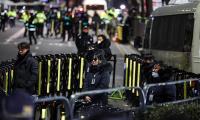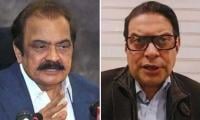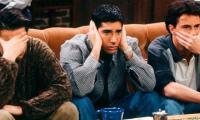WASHINGTON: US Federal Reserve officials, facing economic conditions they say lack any clear historical parallel to guide them, continued pushing back this week against a near-term start to interest rate cuts, instead building the case for caution before making a move they are struggling to justify.
A run of high-profile speeches on Thursday added emphasis to the previous day's hawkish readout of January's policy meeting that bundled together have further shaken investors' confidence that borrowing costs will fall soon.
Coming also on the heels of recent higher-than-expected inflation readings, policymakers put an open-ended formulation around the timing of their first rate cut, with Vice Chair Philip Jefferson saying it was likely but "later this year."
Fed governors Lisa Cook and Christopher Waller later reiterated the now-familiar refrain of needing greater confidence that inflation is on track to return to the Fed's 2 percent target before agreeing to rate cuts.
Waller spoke of being in "no rush" to cut rates given the latest "hotter-than-expected" readings of employment, economic growth and inflation. Cook, meanwhile, was explicit about her "growing confidence that inflation will continue to ease," but also said she needed more proof of that before cutting rates.
Investors have struggled to stay abreast, but have now pushed back expectations of an initial rate cut to June. "As strong activity data have piled up, Fed officials have become less concerned about the risk of keeping the funds rate too high for too long," Goldman Sachs economists wrote on Thursday night as they pushed their rate cut call from May to June.
DEEPER QUANDARY
Policymakers' remarks reflect the near consensus at their Jan. 30-31 meeting that, even after a year when inflation declined at a historic pace and by many measures seems set to fall further, the time still wasn't right to signal the start of rate cuts. "Most participants," according to meeting minutes, were still focused on the risk that premature rate reductions might allow inflation to rise again and force a damaging policy response to erase it.
But the recent commentary also points to a deeper quandary that may be tilting Fed officials toward further delay. The benchmark overnight interest rate has been at 5.25 percent-5.5 percent for nearly seven months, still less than the roughly 10-month average rate "hold" in Fed policy cycles since the mid-1990s.
Officials know what they gain for each month they wait: More downward pressure on prices through borrowing costs they regard as restrictive, more data to show how inflation is behaving, and more confidence they have the situation under control.
For now they neither feel they are paying a price in lost jobs or economic potential for keeping rates where they are nor do they know what they'd gain by cutting them. The economy has held up better than expected in the face of the fastest interest rate increases since the 1980s. If anything that has contributed to uncertainty about whether it reacts to interest rates in the same way it used to - whether financial conditions are, in fact, as restrictive as policymakers believe.
One initial argument for rate cuts - that Fed policy should follow inflation lower in order to keep "real" borrowing costs from rising - has now been discounted.
Jefferson, asked Thursday why he did not mention the issue as a factor in the rate discussion, said he was only focused on whether supply and demand in the economy appeared to be coming into balance - a view aligned with Fed Chair Jerome Powell's distaste for unobserved economic parameters, like the "neutral" rate of interest, as a guide to policy.
NO RUSH
At his last press conference Powell said the Fed wouldn't "wait around for the economy to turn down" before cutting interest rates, "because that would be too late." But there's been no clear case made yet for what would motivate the start of rate cuts or how they'd be calibrated.
Jefferson noted in most cases when the central bank reduces interest rates it is doing so to support a weakening economy, which isn't the case now.
In recent decades the Fed has tackled high inflation, but killed the economy in the process; it has sustained periods of growth with deft rate cuts, but in the absence of excessive price pressures; and it has allowed the unemployment rate to ride along at historically low levels, but that was also because inflation stayed around or even below the 2 percent target.
It has never calibrated rate cuts in the climate policymakers now face: with an inflation surge seemingly controlled but with officials nervous about a rebound; a potentially strong period of purchasing-power recovery underway for workers whose pay is rising faster than prices; and all to the backdrop of a high-stakes presidential election.
The situation has left the economics profession all over the map, with some, including a past Fed vice chair, arguing that a rare "soft landing" has already been achieved, others saying the Fed is at risk of letting inflation rekindle with its talk of cuts, and others that the chance of a recession-inducing policy mistake are rising by the month.
With no past episode as a guide, Fed officials have started referring to the art and intuition of policymaking, even as they say they remain "data dependent."
Waller was, typically, the most blunt in assessing the situation.
"The strength of the economy and the recent data we have received on inflation mean it is appropriate to be patient, careful, methodical, deliberative – pick your favorite synonym. Whatever word you pick, they all translate to one idea: What’s the rush?"
People walk out of a branch of Mashreq bank at Dubai Internet City on Feb. 5, 2012. — Reuters/FileKARACHI: Mashreq...
Jazz headquarters are seen in this file photo. — X@Jazz/FileLAHORE: Veon Group has invested $15 million in Mobilink...
A representational image of gold jewellery. — AFP/FileKARACHI: Gold prices rose by Rs1,100 per tola on Thursday in...
A rainbow is seen over apartments in Wandsworth on the River Thames as UK house prices continue to fall, in London,...
Shoppers browse merchandise in a shopping mall on Orchard Road, in Singapore December 23, 2022. — ReutersSINGAPORE:...
Apple Iphone can be seen in this image. — Unsplash/FileBEIJING: Apple is offering rare discounts of up to 500 yuan ...







